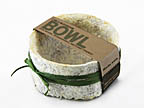
While still in school, company co-founders Eben Bayer and Gavin McIntyre noticed the strong bond that mycelium—mushroom roots— formed with wood chips. That observation has become the basis for a rapidly expanding business that is supplying protective packaging for companies such as Dell and Steelcase as well as the National Oceanic and Atmospheric Administration (NOAA).
A wide variety of agriculture byproducts can be used as the raw material from buckwheat hulls to cotton burrs. The material is cleaned and blended, then inoculated with mycelium. Molds are made specifically for each product: a wine bottle, a computer, a steel table, or an ocean buoy. Once they are filled with the mixture they are left alone to grow in a storeroom without light, water, or any additives.
Five to seven days later, the forms are removed, and the material goes through dehydration and a heat treatment process to stop growth and ensure there will be no spores and related allergen concerns. Now they are ready to protect products loaded on trucks, trains, planes, ships, or even a wagon.
Nature has supplied the raw materials as well as most of the energy to produce the product. Known as EcoCradle Packaging, its cost is already competitive with the big players in the field as well as being completely biodegradable. NOAA purchased the material for use in the ocean where it will biodegrade in five months.
Packaging is only the beginning for Ecovative Design. With a multidisciplinary team of biologists, mycologists, engineers, environmental scientists, and manufacturing experts, they are already creating new applications and products that could revolutionize any number of industries from aerospace and building to fashion and food storage.
For more information: www.ecovativedesign.com


